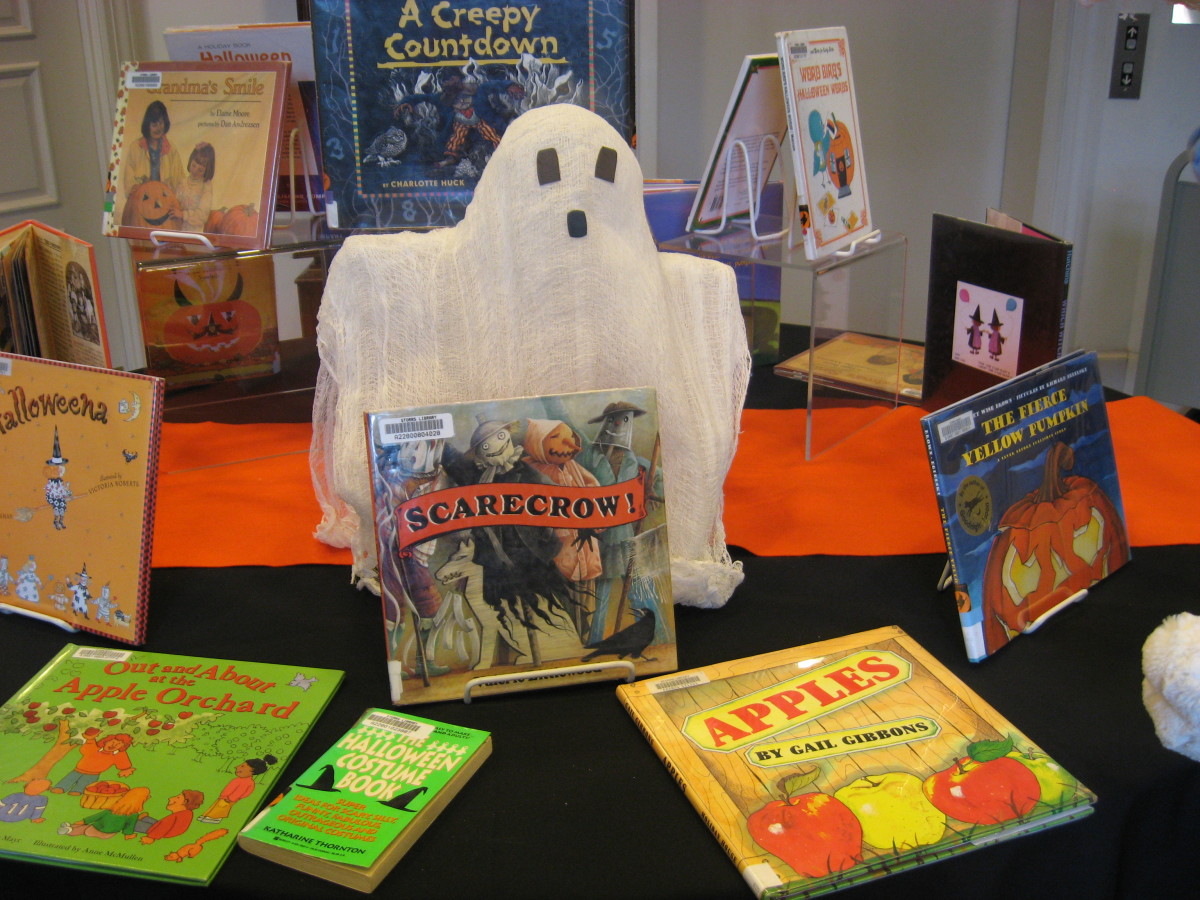Shoes With Buttons
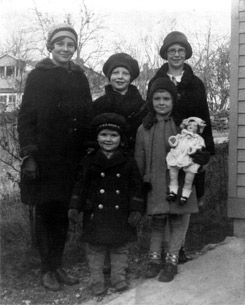
Shoes with Buttons: Remembrances by Louise Margaret Johnson
Louise Margaret Johnson tells gentle stories of growing up in the 1920s and 30s that give insights into a time now past. Through the memories of practical living during the Great Depression and World War II, one begins to develop an understanding of character development and how to face adversity, as well as how the twists, turns and decisions in our life can be God's hand at work to shape what we become and how we impact our family and the world.
Table of Contents
1 - Shopping & Stores
2 - Growing Up
3 - People I Knew
4 - Cures & Treatments
5 - Early Schooling
6 - College & Beyond
7 - Marriage & War
Appendix
Index
Pictured at left: The author, Louise Margaret Johnson (far left), with her siblings and cousins outside their home in 1928.
'Shoes with Buttons,' a Book of Simple Memories
Stories from an earlier era when life, like the shoes we wore, were different
The shoes were always black. Black was better, grandfather said. More practical. Better dyes. Martin Jordan should know. He was a shoemaker and practical German immigrant.
Practical realities drove life in that era. Soup made from chicken feet, salvaging unburnt coal from the furnace ashes, and winters with daily does of cod liver oil. These are some of the memories shared by Louise Margaret (Plate) Johnson in Shoes with Buttons.
Woven together, these memories become a story traversing adversities and opportunites. The result is a book that helps understand yesterday, as well as providing an example of how to reach for tomorrow.
'Stories of growing up through the Great Depression and World War II told in a highly personal voice
Download a Free Electronic Copy of the Book - Available at Lulu.com.
- Download a free, electronic copy of "Shoes with Buttons" from Lulu.com
This memoir is availble as a 88-page paperback from Lulu.com, where you can also download a free electronic copy of the book. No strings attached. No registration required. Why is the author giving away free books? Because she wants you to enjoy the
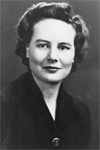
About the Author: Louise Margaret Johnson
My mother, Louise Margaret Johnson, was born in 1918 in Harlem, a section of New York City. Her parents, Hermann Plate and Louise Jordan, were hard-working second-generation German immigrants. Her experiences growing up in the heart of the depression and through World War II produced the intriguing and enjoyable stories found in Shoes with Buttons.
Making Soup from Chicken Feet during the Depression
From Chapter 1: Shopping & Stores
We had two butcher stores in Mt. Vernon, at different ends of town. The one on Fourth Avenue was the bigger one. We knew the fella there quite well. Mother used to shop with him quite frequently, and she often sent me in there, saying "Ask for John."
They may have four or five butchers all behind the counter. The meat would be on the counter like you see today. Instead of being in the back room, the butcher had the butcher blocks right behind the counter. He would take what you wanted out of the case and cut it up for you.
Often I would go over there and I would buy a chicken for our family. When you get a chicken it's nice that you don't have to clean it. At that time, the butcher would clean the chicken for you, although lots of people didn't even bother having them do this. They would just cut off the head, and throw it away. Cut off the feet and cut the innards out of the chicken. They would save for you the heart, the liver and what else - imagine all that service!
Mother would say, "Ask them for an extra couple chicken feet." Most people didn't want the chicken feet. The butcher would throw in a good handful of chicken feet if he had some. Some days, he didn't have any because if people weren't buying chickens the butcher wouldn't have any extra parts on the side of his butcher block where he threw the scraps.
So I would take the chicken feet home. Mother would wash them and scrub them with a brush. Then she would pour boiling water on them and take off the skin. The skin would peel right off them at that point. She would take off the nails and then cook them in a pot. The broth you got off of that after it cooled was real glutinous. She would strain and throw the bones away and use the chicken broth. Since we cleaned our own chickens, I skinned many a chicken foot in this way.
But can you imagine anyone in this day and age using chicken feet? So I suppose it was just another thing for the "old school." We made everything go a long way, I'll tell you. You think about it now, oh, brother! We were in poverty, but we didn't know it.
Wash Day in the 1920s
From Chapter 2: Growing Up
On wash day, the dirtiest clothes were soaked then scrubbed against a wash board propped in the wash tub. The wash tub was an integral part of a kitchen. It often had an enamel covered steel lid so that it could be used for counter space when closed.
Next, all the whites and light-colored items were boiled on the stove in a wash boiler. These were copper and had lids large enough to cover two burners on a gas stove. A wash stick was used to push the clothes down as they started to boil, since they would rise and cause the water to boil over. The stick was also used to pull the hot clothes out into a tub to be rinsed. If you were lucky, you might have a portable wringer, which was two rollers with a handle that turned it. This made wringing the clothes easier. Otherwise you used your hands.
The wash line was frequently located outside a kitchen window or porch. The line was moveable, with two pulleys. The other end would be attached to a tree or pole. In the winter the clothes froze and when removed would stand by themselves. Papa's long johns sure looked funny when they froze. The more fortunate would dry clothes during the winter in a basement, porch or even a spare room. Some items were dipped in a Niagara or Argo laundry starch solution before drying.
Mastoid Operation
From Chapter 4: Cures & Treatments
I had two mastoid operations. The first was when I was 13 months old. George having Scarlet Fever precipitated the second one. An ear infection that doesn't clear up causes an infection of the bone that is right behind your ear. Nowadays, when kids get an earache or a sore throat, they get a shot of penicillin or some antibiotic. That takes care of the whole thing.
But in those days you didn't have anything like that. So when you got an ear infection, you could get an abscess on the inside. When it didn't drain properly and didn't heal properly, this bone back here got infected. It was a very, very common problem during those years.What they actually did is they would make an incision down to that bone. Then they would actually scrape the bone and get the matter off of it.
Because of my brother having Scarlet Fever, I could only see this doctor after everybody else was gone. They probably fumigated the place after I left. It got to the point that nothing was doing very well. I was referred down to New York. He said the operation had to be done, but he was afraid to take me in because of the fact that I might come down with Scarlet Fever. I didn't have Scarlet Fever, but he was afraid I might break out, so he took it upon himself with very much caution. I had to wait a certain amount of incubation time and nothing happened. He took me down to the hospital and he operated. I must have been in the hospital a better part of a week, if not more.
After it was over, I had to go back down to his office a couple of times. He would irrigate my nose and it would come out your mouth. It was a messy procedure and it hurt, too. And wouldn't you believe one day he dropped dead while we were going to him. He had a heart attack and he just died.
You don't hear about mastoid operations anymore. With antibiotics you don't have those problems. But it was a dangerous operation. At points, it was life threatening if it went too far, because the pus might get up into the skull.
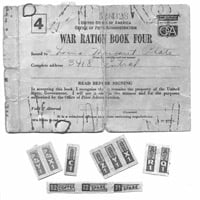
Rationing during World War II
From Chapter 7: Marriage & The War
Living during World War II was rather restricted. Everyone had a coupon-like ration book. You had to tear off the little pieces to be able to buy sugar, shoes, butter, gasoline and other things. If you spent all your stamps early in the month, then you didn't have any coupons at the end of the month and you did without. You weren't supposed to trade these, but I wouldn't say it wasn't done. You got used to using these, just like we're used to paying sales tax on things today.
A ration stamp booklet from World War II.
President Roosevelt said, "Rationing would be necessary for full defense productivity. Never before has our American civilization been in such danger. We must be the great arsenal of democracy."
Another restriction during the war was with clothing. The clothes we got during the war were also kind of chinsy. The suit that I had on when I got married wasn't up to scratch. You wouldn't buy it nowadays. But that's what you got because the military was using the best of the fabrics and the general public got what was left over. Silk stockings were also rationed, starting in 1941. Of course, we didn't have nylons then.
Travel was also more difficult. You didn't go on vacations because transportation was limited. You just didn't go. If you were lucky enough to have a car, your gasoline was rationed and you didn't drive very far. We'd share rides and some of our ration tickets to pay for the gas. It was something special to go from one place to another.
'We were in poverty, but we didn't know it.'
Living in the Quonset Hut after World War II
From Chapter 7: Marriage and The War
After a while we got the chance to move into a Quonset hut. These were a built from a large half-circle of corrugated metal set on a concrete base. They could be built fast and were luxurious by comparison to the trailers. It had concrete floors, inside plumbing, a flush toilet and even a shower all to yourselves. There was a built-in kitchen unit where you had a stove, refrigerator and sink all in one unit.
When the doors were closed you didn't see anything, but when you opened it up and you had everything behind it. We even had a washing machine that we bought ourselves. We hung the clothes out on the line in the lawn. We lived there in '51 when Peggy (Margaret or "Meg") was born. There were no luxuries, but compared to putting the slop bucket underneath the sink it was the height of luxury.
Lychee Nuts
Lychee nuts are mentioned in Chapter 1. Additional background on this unusual fruit is provided for the reader in the Appendix.
Lychee nuts, also called litchi nuts or leechee, are not a nut at all, but rather an unusual fruit that looks something like a strawberry. The skin is deep red to brown in color and the fruit about an inch to an inch and a half in diameter. When peeled, the pearly white inside looks like a grape, and is likewise smooth and juicy. The smooth brown seed on the inside is not edible.
Lychee nuts are most often eaten out of hand. When peeled and pitted they can be added to fruit salads. Other common way to serve the fruit is stuffed - with cottage cheese, a blend of cream cheese and mayonnaise, or with pecan meats topped with whipped cream.
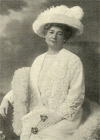
Madame Shumann-Hienk
The author's mother was a seamstress at the firm designing the opera star's clothes. The book's appendix has more details about Shumann-Hienk.
Ernestine Schumann-Heink was one of the great opera singers of the early 20th century, performing throughout Germany, England, and America.
She was admired for her virtuosity as a contralto, which is the lowest female voice or voice part, intermediate in range between soprano and tenor. While best known for her brilliant singing, she was also popular with her audiences because of her warm and charming personality. During the height of her popularity she was called the titan of the opera and "the world's greatest contralto."
Schumann-Heink was born Tini Rossler in 1861 in what is now part of the Czech Republic, although at the time it was Austria. Her father was a shoemaker and former Austrian cavalry officer. At age 17 in 1878 she debuted in Dresden, Germany as Azucena in Verdi's Il Trovatore.
Schumann-Heink was fiercely patriotic to her adopted country and became a naturalized U.S. citizen in 1905. She made a point of flying a large American flag over her various homes. She performed for servicemen during World War I and toured the United States raising money for the war effort, even though she had sons fighting on both sides of the conflict.
Your turn - Write a review, add a comment, or debate someone who disagrees with you.
What did you think?

